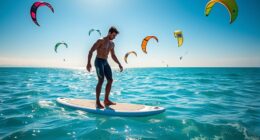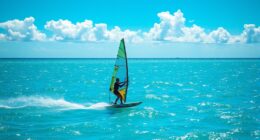To build upper body strength for canoeing, focus on exercises like push-ups, pull-ups, and rows to enhance your shoulders, arms, and back. Incorporating core stability exercises like planks and Russian twists is also vital for balance and power transfer. Don’t forget grip endurance with hand grippers and farmer’s walks to maintain control during long paddles. Proper technique is key, and if you’re enthusiastic to boost your performance, there’s more to explore on integrating strength training and technique.
Key Takeaways
- Focus on exercises like push-ups, pull-ups, and rows to enhance shoulder, arm, and back strength essential for effective paddling.
- Incorporate core stability workouts, such as planks and Russian twists, to improve balance and power transfer during canoeing.
- Develop grip endurance with hand grippers and farmer’s walks to maintain paddle control and prevent fatigue during long paddling sessions.
- Practice proper paddling technique alongside strength training to maximize performance and efficiency on the water.
- Ensure you have the right gear, including water purification systems, to support endurance and safety during extended canoe trips.

Have you ever wondered how to paddle faster and more efficiently in your canoe? The secret often lies in building your upper body strength. Enhancing your strength isn’t just about brute force; it’s also about developing core stability and grip endurance. These two elements play a critical role in maximizing your paddling performance.
To start, focus on exercises that target your shoulders, arms, and back. By strengthening these muscle groups, you’ll gain more power with each stroke. Think about incorporating push-ups, pull-ups, and rows into your routine. These movements will help you build the essential muscles needed for effective paddling. You’ll notice that as you become stronger, you can paddle longer distances without tiring out. This improvement isn’t just about muscle strength; it’s also about how efficiently you use that strength.
Core stability is essential for maintaining balance and control while you paddle. A strong core allows you to transfer power from your upper body through your torso into the paddle. You can improve your core strength by including exercises like planks and Russian twists in your workouts. When you engage your core during paddling, you’ll feel more stable, which translates into better technique and speed. A stable core ensures that your body remains aligned, reducing the risk of injury and allowing for more effective strokes.
Grip endurance is another critical factor in your paddling success. If your grip weakens during a long paddle, your strokes will become less effective, and you’ll lose power. To build grip endurance, consider using hand grippers or performing farmer’s walks. These exercises will help your hands and forearms develop the stamina needed for prolonged paddling sessions. You’ll find that, with improved grip endurance, you can maintain better control of the paddle, allowing you to execute each stroke with precision.
Moreover, don’t forget about the importance of proper technique. As you build strength, pay attention to how you paddle. Efficient technique can amplify the benefits of your strength training. A consistent practice of drills will help you integrate your newfound strength into your paddling style. Additionally, incorporating water purification systems into your canoeing gear can ensure that you have safe drinking water while on longer trips, enhancing your overall endurance and performance.
Frequently Asked Questions
What Specific Muscles Are Most Important for Canoeing Strength?
The most important muscles for canoeing strength include your core muscles and those responsible for shoulder stability. A strong core helps you maintain balance and control while paddling, while shoulder stability ensures you have the strength and mobility to execute smooth strokes. Focus on exercises that target these areas, like planks and rotator cuff workouts, to enhance your overall performance and diminish the risk of injury when you’re out on the water.
How Often Should I Train My Upper Body for Canoeing?
To truly excel, you can’t just paddle; you’ve got to train. Aim for a suitable schedule of upper body workouts three to four times a week. This training frequency allows your muscles to recover while building strength effectively. Mix in exercises targeting your back, shoulders, and arms for balanced development. Listen to your body—if you’re feeling fatigued, don’t hesitate to take a rest day to guarantee you stay strong and ready for the water!
Are There Any Dietary Recommendations for Building Strength?
To build strength, focus on nutrition planning that includes lean proteins, healthy fats, and whole grains. Incorporate foods like chicken, fish, nuts, and quinoa into your meals. You might also consider supplement options like protein powder or branched-chain amino acids to support muscle recovery. Staying hydrated is vital, too. Aim for balanced meals and snacks throughout the day to fuel your workouts and aid in muscle growth effectively.
Can I Train Upper Body Strength at Home?
Yes, you can definitely train upper body strength at home! Focus on bodyweight exercises like push-ups, pull-ups, and dips to build muscle. Incorporate resistance bands for added resistance; they’re great for exercises like bicep curls and tricep extensions. You can easily adjust the intensity by changing the band’s tension. Consistently challenge yourself with varied movements, and you’ll see progress in your upper body strength without needing a gym!
How Long Until I See Results From My Training?
You can typically see results from your training in about four to six weeks, depending on your consistency and effort. As you build muscle endurance, focus on incorporating effective recovery strategies like proper hydration, nutrition, and rest. These will help your muscles recover and grow stronger, enhancing your progress. Remember, everyone’s body responds differently, so be patient and stay committed to your routine for the best outcomes.
Conclusion
In the world of canoeing, building upper body strength isn’t just a nice-to-have; it’s a game changer. As you strengthen your arms, shoulders, and back, you’ll paddle like a pro, steering through water with ease. Remember, it’s not just about brute force; technique and endurance matter too. So, don’t wait any longer—get started on your strength training today, and soon, you’ll be paddling circles around the competition! After all, practice makes perfect!










